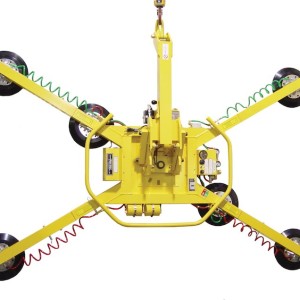VACUUM

Vacuum Lifters/ Handling / Vacuum Lifting Equipment from Concord Lifting Equipment Ltd
Concord Lifting Equipment Ltd stands out from the crowd when it comes to Vacuum handling. We are one of the few companies in the UK that offer hire, sales, testing, certification and maintenance and repair for vacuum lifting and handling equipment – and carry a full range of handling accessories that every project needs to get the job done. All hire vacuum units can be used in conjunction with our lifting equipment. ie; you can lift a vacuum handling machine on a Roust-a-bout and combine lifting and vacuum handling from one source.
Concord are proud to carry a range of glass, plate glass and cladding lifting equipment products from Woods Powr Grip from the USA.
If you are experienced with vacuum handling, we have got everything you need, if you are unsure, we have the expertise and equipment to point you in the right direction.
Vacuum Accessories & Testing
Stillages, A-Frame trolleys, Safety harnesses – Concord have all the relevant accessories for you to get the best from your glass lift. And it’s not just sales and hire, Concord offer service, maintenance and repair as well. In-house on our portrait and landscape testing rigs at the depots or on site (thorough examination only).
Self-contained & Mains operated
Concord carry a full range of self-contained battery operated (either 110v or 240v charging) and mains operated glass handling vacuum equipment to fit your site and project needs. All our vacuum lifters are dual circuit and suitable for construction sites.
We are on of a handful of specialists in vacuum lifting equipment providers in the UK, and part of an even smaller club that offer a comprehensive range of vacuum handling and lifting equipment.
Whether you are a manufacturer, fabricator or installer, lifting, moving and positioning materials are always a challenge. Designed to handle this challenge, vacuum lifters provide an efficient, cost-effective and oftentimes more secure method of moving materials from one place to another. This not only saves time and increases profit but, by reducing worker fatigue and injuries, also helps create a more effective, productive and secure working environment.
Vacuum lifters are available in a variety of styles specially designed for materials handling applications. Hand-held models are most often used for applications where dimensions and weight are conducive to one- or two-person handling. Below-the-hook lifters are employed when lifting larger materials into multi-level buildings, loading and unloading fabrication equipment, or when manpower availability dictates single-person operations. Vacuum lifters attach to the face of the material, leaving the edges free for installation or loading onto processing machinery.
Hand-Held Lifters
Hand-held vacuum lifters, usually called hand cups, vacuum cups or suction cups, use a manually operated pump, flip-style lever or simple press-on application to create vacuum. Once attached, vacuum cups provide a convenient handle to lift and position a variety of materials. Different models are available for handling flat and curved materials. Additionally, different rubber compounds and durometers are available for applications requiring low-marking, temperature resistant or chemical resistant pads.
The weight and type of material often determine the most appropriate style. For larger loads carried over longer distances, pump-style cups offer the greatest advantage. Pump-style cups are attached by pumping a plunger that removes air from between the load surface and the rubber pad. Most styles also feature a line on the plunger that serves as a vacuum indicator. When the cup is fully evacuated and ready to lift, the plunger stays in and the line is not visible. Should the line reappear during the lift, a check valve allows the operator to repump the cup without loss of remaining vacuum.
For lighter, smaller loads, where speed of handling may be more of a concern, flip-style or push-on plastic or rubber cups may be the appropriate choice. When using manually operated vacuum cups, it is important that the load surface and the vacuum cup itself be relatively free of contaminates that may cause the material to slip. This is particularly true for push-on and flip-style cups, because vacuum indicators are generally not present, and because the vacuum level attained may be less than that of pump-style cups.
Below-the-hook lifters
For heavier loads, AC, DC or Air-powered below-the-hook vacuum lifters move large sheet materials with the aid of floor hoists, overhead systems or forklifts to support the weight of the load.Below-the-hook lifters are available in models that provide powered or manually operated rotation and tilt or in versions strictly for handling materials in the upright or flat position.
When selecting a lifter, first assess the job(s) it is expected to do. List the features and functions needed in terms of material size and weight, load manipulation, available power and ergonomic issues. For some, the ideal lifter is one that does everything reasonably well; versatility is the primary consideration. For those involved in medium- to high-volume production, speed and ease of handling are of prime importance. Keep in mind that a single lifter may not always be the most effective answer to your handling needs. Specialized lifters dedicated to one aspect of an operation sometimes lead to greater efficiency and may be just as cost-effective.
Capacity and Support
Load capacity ratings on lifters include a safety factor calculated to cover variations in slip resistance, due to contamination on the material or pads, and weight magnification which may occur when cranes or hoists are not operating smoothly.
When referring to capacity, some handlers may only consider load weight. However, the support the pad frame supplies across the material is equally important. Support requirements depend on the angle and the thickness of the material during the lift. The lifter’s pad spread must limit overhang and provide adequate support to prevent bending or breaking the material.
In addition, the overhead system, crane or hoist must be rated to lift the combined weight of the lifter and the load, for safe operation.
Load Manipulation
One of the most significant contributions of below-the-hook lifters is their ability to help lift and manipulate materials without excessive strain to the user. This includes a range of movements, from simply moving materials from one place to another in upright or flat positions to providing touch-of-a-button tilt and rotation. Whatever the job requirement, below-the-hook lifters have been designed with the manipulation capabilities to help move the material quickly and effortlessly
Speed
Lifter speed is the time required to move an object from where it is to where you want it. Factors such as the apply and release times, the time required for a powered tilt or rotation cycle, the number of times per hour the movement is performed, and the distance the load must travel are important considerations. Once speed and frequency requirements have been determined, Concord Lifting will be able to provide a lifter with capabilities to fill the need.
Power
Vacuum lifters are available in most standard AC voltages, 12 volts DC, or compressed air versions. AC electric or air power are normally chosen for high-speed, production operations. For installations, or when a lifter must be used in several locations, self-contained DC lifters are most popular.
Videos of Vaccum Lifting in Action!
Here are some videos of some of the vacuum handling equipment we offer

